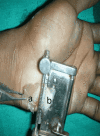Second-Layer Palmar Graft for Fingertip Reconstruction: An Analysis of Aesthetic and Functional Outcomes
- PMID: 35602786
- PMCID: PMC9117113
- DOI: 10.7759/cureus.24257
Second-Layer Palmar Graft for Fingertip Reconstruction: An Analysis of Aesthetic and Functional Outcomes
Abstract
Background: Fingertip injuries are very common and require a stable and durable cover. The end result after reconstruction must be a painless finger with good aesthetic appearance. Skin loss in fingertip, with or without partial loss of pulp fat, is often managed with a split-thickness skin graft, which causes a poor aesthetic result due to color mismatch of the grafted skin in the glabrous volar skin of fingertip. The full-thickness and partial-thickness skin graft harvested from palmar skin provide color match but may cause donor site morbidity in the form of painful scar or contour deformity. Harvest of the second layer from the palm (intermediate part of dermis) allowed the first layer (epidermis with superficial part of dermis) to be reposed over the remaining dermis in palm, thus allowing closure of donor defect without any tension. This technique provides a good color match for the primary defect, along with reduced donor site morbidity.
Aim: The study aims to analyze the outcomes of second-layer palmar graft (SLPG) in patients with fingertip injuries.
Materials and methods: The retrospective study was conducted in January 2012 on 40 patients who underwent SLPG.
Result: The graft take was 100% in 36 patients with an average static two-point discrimination (2PD) of 6 mm. The average cosmetic visual analog score for the donor area was 100 and recipient site was 80.
Conclusion: The SLPG is a good surgical procedure for reconstructing fingertip defects, providing excellent aesthetic appearance and optimal function.
Keywords: fingertip injuries; glabrous dermal grafting; glabrous skin grafting; keratin sparing split skin graft; second layer palmar graft; skin graft.
Copyright © 2022, Rajendiran et al.
Conflict of interest statement
The authors have declared that no competing interests exist.
Figures






Similar articles
-
Combination of the Adipofascial Cross-Finger Flap and Glabrous Skin Graft for Fingertip Reconstruction.J Plast Reconstr Surg. 2022 Jan 27;1(1):11-19. doi: 10.53045/jprs.2021-0002. eCollection 2022 Jan 27. J Plast Reconstr Surg. 2022. PMID: 40458698 Free PMC article.
-
Treating complex palmar-plantar wounds using a bilaminar 'trapdoor' technique: a case series.J Wound Care. 2021 Oct 2;30(10):868-873. doi: 10.12968/jowc.2021.30.10.868. J Wound Care. 2021. PMID: 34644142
-
Glabrous dermal grafting: a 12-year experience with the functional and aesthetic restoration of palmar and plantar skin defects.Plast Reconstr Surg. 2005 Nov;116(6):1679-85. doi: 10.1097/01.prs.0000186662.43997.48. Plast Reconstr Surg. 2005. PMID: 16267432
-
Optimizing aesthetic results in skin grafting.Am Surg. 2012 Feb;78(2):151-4. Am Surg. 2012. PMID: 22369820 Review.
-
[Free gracilis muscle flap with plantar intermediate thickness skin graft: case report, review of anatomy and functional reconstruction of the palm].Handchir Mikrochir Plast Chir. 2011 Aug;43(4):255-61. doi: 10.1055/s-0030-1267914. Epub 2011 Aug 10. Handchir Mikrochir Plast Chir. 2011. PMID: 21833880 Review. German.
References
-
- Repair of injuries to soft tissues of fingers, primary and secondary reconstruction. Gonzalez RI, Buncke Jr HJ. http://pubmed.ncbi.nlm.nih.gov/13900220/ Calif Med. 1962;96:347–349. - PMC - PubMed
-
- Split-thickness plantar skin grafts for coverage in the hand and digits. Robotti EB, Edstrom LE. J Hand Surg Am. 1991;16:143–146. - PubMed
-
- Glabrous dermal grafting: a 12-year experience with the functional and aesthetic restoration of palmar and plantar skin defects. Wu LC, Gottlieb LJ. Plast Reconstr Surg. 2005;116:1679–1685. - PubMed
-
- The palmar split skin graft. Worthen EF. Br J Plast Surg. 1973;26:408–411. - PubMed
-
- An assessment of clinical wound evaluation scales. Quinn JV, Wells GA. Acad Emerg Med. 1998;5:583–586. - PubMed
LinkOut - more resources
Full Text Sources
